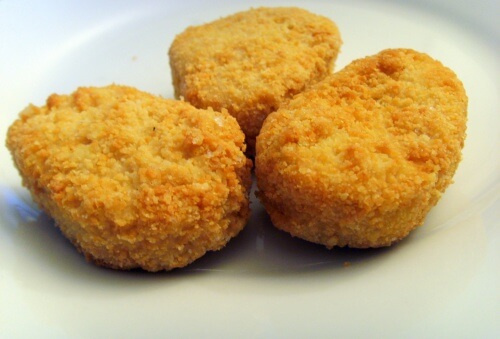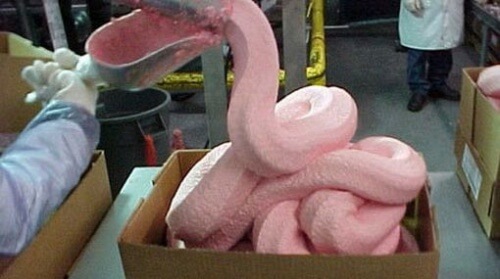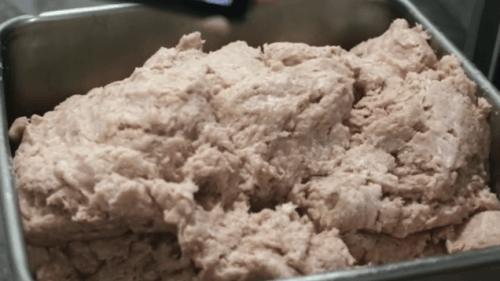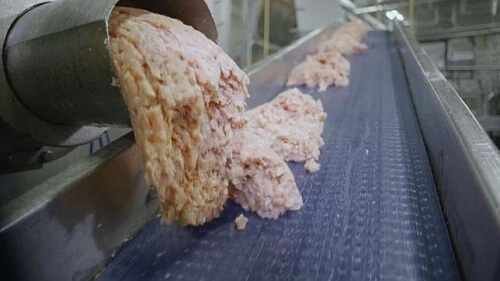What Are Chicken Nuggets Really Made Of?

We’re all familiar with those little deep-fried nuggets that you can find at almost any fast food joint or even in your own freezer. We see them everywhere – their crispy, golden goodness tempting us through all sorts of delicious-looking ads. But what are chicken nuggets actually made of? We’ll explain in this article and then you can decide whether or not you want to keep eating them.
Their delicious and perfect golden brown image makes our mouths water every time we see them. We’re may believe that they’re a healthier choice for our children because chicken meat is, supposedly, healthier than the alternatives. The doctor may have even told you to avoid red meat because of the cholesterol it contains.
So you choose chicken nuggets, believing you were safe from high triglyceride levels. The next time you’re looking over the menu at a fast food restaurant or trying to decide what to pack for lunch or make for dinner, take a moment to think and make an informed decision first.
Also Read: Effective Diet to Reduce Bad Cholesterol
How do they make chicken nuggets?
Those tasty chicken nuggets that seem like a healthier alternative to a hamburger are actually made from a pink paste that resembles strawberry frozen yogurt or bubblegum. It’s made by grinding and mechanically separating whole chickens. Michael Kindt recently revealed this on his blog, Early Onset of Night.

But it doesn’t stop there. The pink mass that you get from this process is full of bacteria. What do they do to get rid of the bacteria? They sterilize it with an ammonia bath, a simple and disgusting procedure.
If it ended there, we’d be assaulted by the smell of ammonia every time we cooked up some chicken nuggets. To hide the taste and smell of the chemical disinfectant, they cover it up with artificial coloring and flavorings (when we think about it, those additives are in a lot of the food we eat every day).
See Also:9 Bacteria Dangerous to Humans
The renowned chef, James Oliver, is responsible for raising awareness about the process behind chicken nuggets on his TV show, Food Revolution, broadcast by the ABC network. He says he wanted to raise awareness so parents would stop giving this unhealthy food to their children. However, he was unsuccessful in this regard.
Later, the NatGeo channel broadcast a show on foods produced using the “mechanical separation” technique, which explains the origins of chicken nuggets.

Huffington Post Investigates “Fake” Food
This Huffington Post article – known worldwide as “What’s Really in a Chicken Nugget?” – received international attention when it announced that nuggets don’t contain just chicken meat (which is the only thing they should contain) but guts, crushed bones, fat, veins, nerves, cartilage, and around 30 different chemical additives. They contain less than 50% chicken meat, the rest is filler.
The article starts with, “When you order fast food, you know you’re not making a healthy choice, but you at least expect it to be food. Chicken is chicken and meat is meat, right?”
The media has conducted a number of studies on “fake” food. When it comes to chicken nuggets, only about half their content is really chicken meat; the rest contains over 3 dozen additives and fillers, including aluminum sulfate.

The American Journal of Medicine compared the chicken nuggets from two leading fast food chains (they didn’t specify which, but we can reasonably assume which two they were). Nuggets from both chains contained only 50% chicken meat at most, the rest was a mixture of cartilage, nerves, crushed bones, veins and fat.
According to Dr. Richard D. deShazo, from the University of Mississippi’s Medical Center, “companies have chosen to use an artificial mix of chicken parts instead of lean meat.
The manufacturers then batter and deep-fry the result and they are still somehow able to refer to it as chicken. It is a chicken-based product that contains a lot of calories, salt, sugar and fat. It’s not healthy for anyone.”
Are the additives in chicken nuggets harmful?
Dr. David Katz, from Yale University, states that this mixture can be harmful, although results from studies are not yet available. Just informing people that chicken nuggets are made from nerves, veins and crushed bones is not enough to get them to stop eating the product; they also need to know that they contain chemical additives to alter the flavor and consistency.
The problem with chicken nuggets is not the parts of the animal that companies use, but the preservatives and chemicals that they add during manufacture.

Returning to the Huffington Post article, they found the anti-foaming agent dimethylpolysiloxane in a piece of fried chicken; you can also find this substance in antifreeze for cars.
Although governmental bodies have not declared these substances to be harmful, they aren’t exactly good for you either. Other fast food producers add MSG, related to headaches and excessive sweating.
In each case, they found high levels of dextrose, an added sugar. Ten units contain 900 mg of sodium before frying, well above the recommended daily dose.
All cited sources were thoroughly reviewed by our team to ensure their quality, reliability, currency, and validity. The bibliography of this article was considered reliable and of academic or scientific accuracy.
- Bhosale, S. S., Biswas, A. K., Sahoo, J., Chatli, M. K., Sharma, D. K., & Sikka, S. S. (2011). Quality evaluation of functional chicken nuggets incorporated with ground carrot and mashed sweet potato. Food Science and Technology International. https://doi.org/10.1177/1082013210382339
- Bonato, P., Perlo, F., Teira, G., Fabre, R., & Kueider, S. (2005). Características texturales de nuggets de pollo elaborados con carne de ave mecánicamente recuperada en reemplazo de carne manualmente deshuesada. Ciencia, Docencia y Tecnología.
This text is provided for informational purposes only and does not replace consultation with a professional. If in doubt, consult your specialist.








